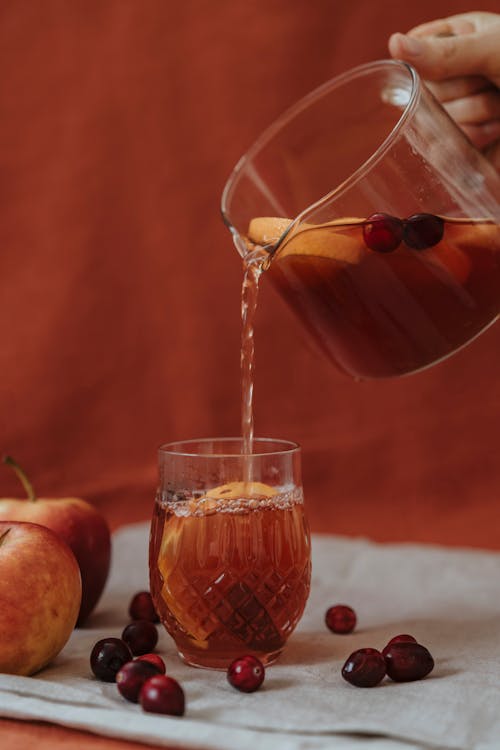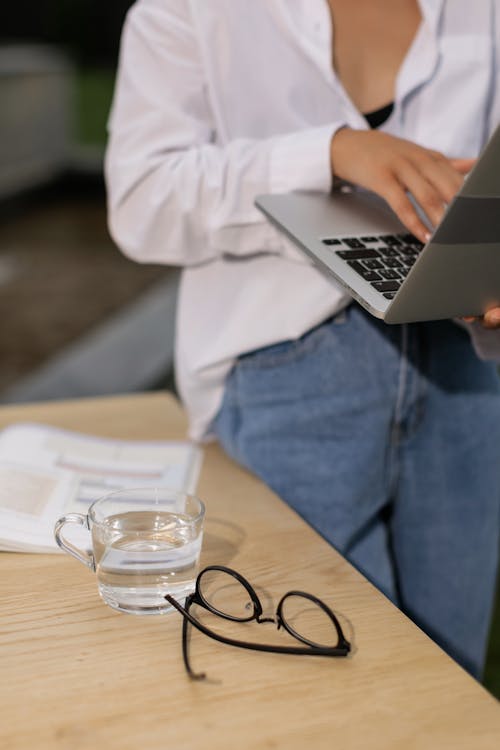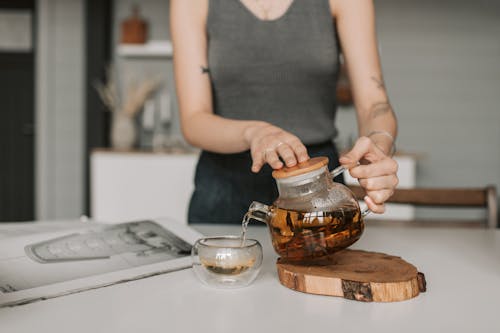If you’re like me, you love a hot cup of coffee or tea in the morning. But sometimes, you don’t have time to boil water or use a kettle. You might wonder if you can just pop your glass cup in the microwave and save some time. Well, the answer is not so simple. It depends on the type of glass, the shape of the cup, and the temperature of the liquid. In this blog post, I’ll explain
everything you need to know about microwaving glass cups safely and effectively.
Yes, you can microwave glass cups as long as they are microwave-safe and have no metal parts. However, you should avoid microwaving thin or delicate glass cups, as they may crack or shatter due to thermal stress. You should also avoid overheating the liquid in the cup, as it may cause it to boil over or explode.
What is Microwave-Safe Glass?
Not all glass is created equal. Some glass is more resistant to heat and temperature changes than others. Microwave-safe glass is a type of glass that can withstand the high-frequency electromagnetic waves that microwaves use to heat food and liquids. Microwave-safe glass does not absorb or reflect these waves, so it does not get too hot or cause sparks.
How can you tell if your glass cup is microwave-safe? There are a few ways to check:
- Look for a label or a symbol on the bottom of the cup that says “microwave-safe” or shows a microwave icon.
- Check the manufacturer’s website or contact them directly to see if they recommend microwaving their products.
- Do a test run by filling the cup with water and microwaving it for one minute on high power. If the cup stays cool or slightly warm, it is likely microwave-safe. If the cup gets very hot or cracks, it is not microwave-safe.
How to Microwave Glass Cups Safely

Even if your glass cup is microwave-safe, there are some precautions you should take to avoid accidents and injuries. Here are some tips on how to microwave glass cups safely:
- Always leave some space at the top of the cup when filling it with liquid. This will prevent the liquid from boiling over and spilling out of the cup.
- Always use a microwave-safe lid or cover to prevent splashes and spills. You can also use a paper towel or a napkin as a cover, but make sure it does not touch the liquid or the sides of the microwave.
- Always stir the liquid before and after microwaving it to distribute the heat evenly and avoid hot spots. This will also prevent superheating, which is when the liquid gets hotter than its boiling point without forming bubbles. Superheated liquid can explode when disturbed, causing burns and damage.
- Always use oven mitts or a towel to handle the cup after microwaving it. The cup may be hotter than you expect, especially if it has a handle that conducts heat.
- Never microwave a glass cup that has cracks, chips, or scratches. These can weaken the structure of the glass and make it more prone to breaking under thermal stress.
- Never microwave a glass cup that has metal parts, such as a rim, a handle, or a decoration. Metal can react with microwaves and cause sparks, fires, or damage to your microwave.
Benefits of Microwaving Glass Cups
Microwaving glass cups can have some benefits over other methods of heating liquids, such as:
- Convenience: You don’t need to use a stove, a kettle, or a pot to heat your liquid. You can just use your microwave and save time and energy.
- Versatility: You can heat different types of liquids in your glass cup, such as water, coffee, tea, milk, soup, or hot chocolate. You can also add ingredients like sugar, honey, lemon, or spices to your liquid before or after microwaving it.
- Hygiene: You don’t need to wash any extra dishes or utensils after microwaving your liquid in your glass cup. You can just drink from the same cup and rinse it afterwards.
Drawbacks of Microwaving Glass Cups
Microwaving glass cups can also have some drawbacks compared to other methods of heating liquids, such as:
- Risk: As mentioned above, there is always a risk of cracking or shattering your glass cup when microwaving it due to thermal stress. There is also a risk of burning yourself or causing an explosion if you overheat your liquid or superheat it.
- Quality: Some people may find that microwaving their liquid in their glass cup affects the taste or quality of their drink. For example, some coffee lovers may prefer to brew their coffee using a French press or a drip machine rather than microwaving it. Some tea drinkers may find that microwaving their tea leaves or bags reduces the flavor and aroma of their tea. Some milk drinkers may find that microwaving their milk changes its texture and consistency.
- Efficiency: Microwaving your liquid in your glass cup may not be the most efficient way to heat it, depending on the size and shape of your cup and the power and settings of your microwave. You may need to microwave your liquid for longer or shorter than you expect, or adjust the power level or temperature settings to get the desired result.
How to Choose the Best Glass Cup for Microwaving

If you want to microwave your glass cup regularly, you should choose one that is suitable for this purpose. Here are some factors to consider when choosing the best glass cup for microwaving:
- Material: As mentioned above, you should choose a glass cup that is microwave-safe and has no metal parts. You should also avoid glass cups that are thin or delicate, as they may not withstand the heat and pressure of microwaving. You should look for glass cups that are thick and sturdy, such as borosilicate glass or tempered glass. These types of glass are more resistant to thermal shock and less likely to crack or shatter.
- Shape: You should choose a glass cup that has a round or oval shape, rather than a square or rectangular one. This will allow the microwaves to penetrate the liquid more evenly and reduce the risk of hot spots or superheating. You should also avoid glass cups that have narrow or tapered openings, as they may trap steam and cause pressure buildup inside the cup.
- Size: You should choose a glass cup that has enough capacity to hold your desired amount of liquid, plus some extra space at the top to prevent boiling over. You should also choose a glass cup that fits well in your microwave and does not touch the walls or the door of the microwave. You should avoid glass cups that are too large or too small for your microwave, as they may affect the heating performance or cause damage to your microwave.
How to Clean Your Glass Cup After Microwaving
After microwaving your glass cup, you should clean it properly to remove any stains, residues, or odors. Here are some tips on how to clean your glass cup after microwaving:
- Rinse: You should rinse your glass cup with hot water as soon as possible after microwaving it. This will help loosen any stuck-on food particles or liquids and make them easier to wash off.
- Wash: You can wash your glass cup by hand using warm water and mild dish soap. You can also use a soft sponge or cloth to scrub away any stubborn stains or residues. You should avoid using abrasive cleaners or scouring pads, as they may scratch or damage your glass cup.
- Dry: You can dry your glass cup by wiping it with a clean towel or letting it air dry on a rack. You should avoid using paper towels or napkins, as they may leave lint or fibers on your glass cup.
- Store: You can store your glass cup in a cabinet or a drawer away from direct sunlight or heat sources. You should avoid stacking your glass cups on top of each other, as they may chip or crack due to weight or friction.
FAQs

Here are some frequently asked questions about microwaving glass cups:
Q: Can I microwave Pyrex glass cups?
A: Yes, you can microwave Pyrex glass cups as long as they are labeled as microwave-safe and have no metal parts. Pyrex is a brand name for borosilicate glass, which is a type of glass that can withstand high temperatures and thermal shock.
Q: Can I microwave crystal glass cups?
A: No, you should not microwave crystal glass cups, as they may contain lead or other metals that can react with microwaves and cause sparks, fires, or damage to your microwave. Crystal glass is also more fragile and prone to cracking or shattering due to thermal stress.
Q: Can I microwave colored glass cups?
A: It depends on the type and quality of the color. Some colored glass cups are safe to microwave if they use food-grade dyes or pigments that do not contain metals or toxins. However, some colored glass cups may use paints or coatings that can peel off, melt, or release harmful chemicals when microwaved. You should always check the label or contact the manufacturer before microwaving colored glass cups.
Q: Can I microwave plastic cups?
A: It depends on the type and quality of the plastic. Some plastic cups are safe to microwave if they are labeled as microwave-safe and have no metal parts. However, some plastic cups may melt, warp, or release harmful chemicals when microwaved. You should always check the label or contact the manufacturer before microwaving plastic cups.
Q: Can I microwave ceramic cups?
A: It depends on the type and quality of the ceramic. Some ceramic cups are safe to microwave if they are labeled as microwave-safe and have no metal parts. However, some ceramic cups may crack, chip, or explode when microwaved due to air bubbles or moisture trapped in the clay. You should always check the label or contact the manufacturer before microwaving ceramic cups.
Conclusion
Microwaving glass cups can be a convenient and versatile way to heat liquids, but it also comes with some risks and drawbacks. You should always use microwave-safe glass cups that are thick, sturdy, round, and have enough space at the top. You should also follow some safety tips to avoid accidents and injuries, such as using a lid or cover, stirring the liquid, and using oven mitts. You should also clean your glass cup properly after microwaving it to remove any stains, residues, or odors.
I hope this blog post has answered your question of whether you can microwave glass cups or not. If you have any other questions or comments, feel free to leave them below. And don’t forget to check out Presstocook.com for more tips and tricks on cooking and baking with your microwave. Thanks for reading! 😊




